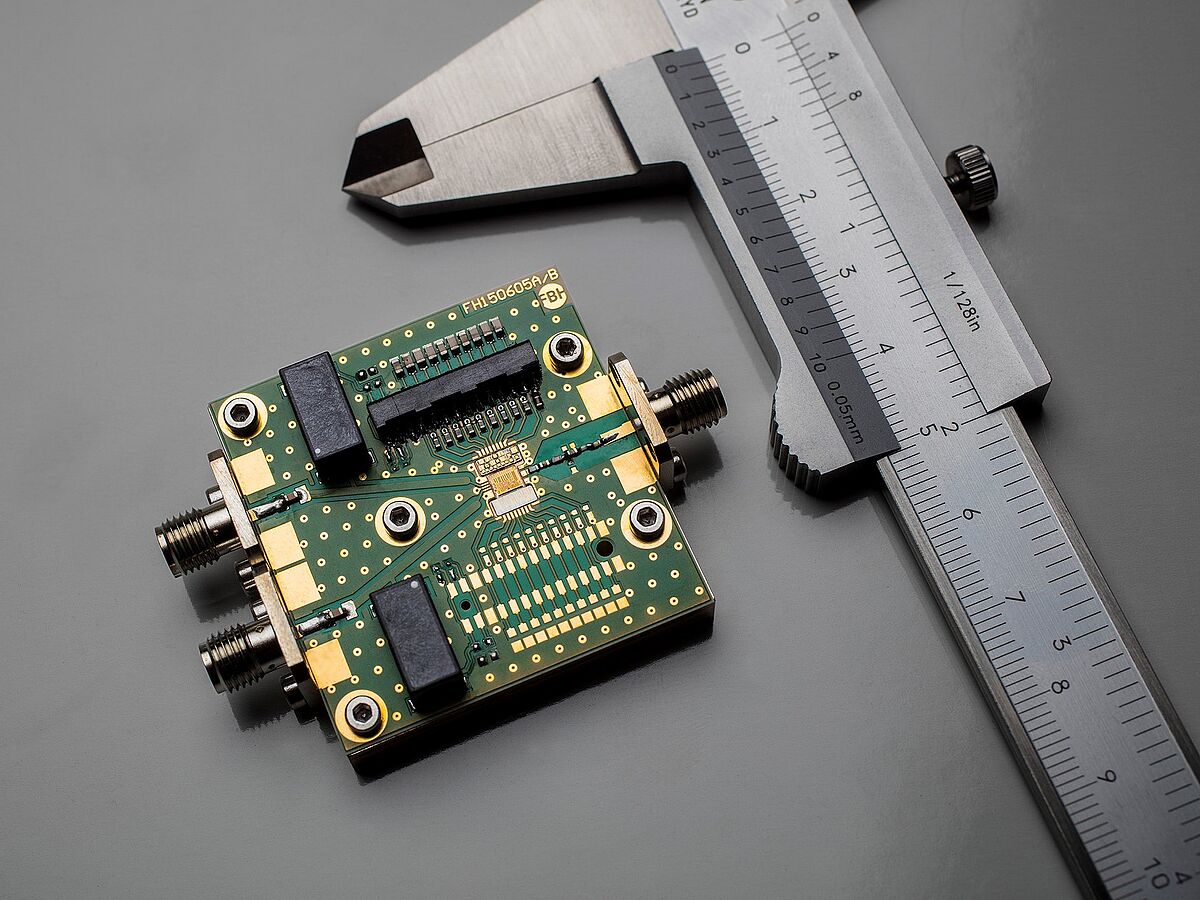The Ferdinand-Braun-Institut demonstrates its capability in III-V electronics at „Productronica“. FBH components are used, among others, for the future mobile communications standard 5G and for industrial as well as biomedical applications
The Ferdinand-Braun-Institut (FBH) presents a selection of current developments and advances of its power amplifiers, circuits, and heterointegrated chips at “Productronica”. The event is hosted in Munich from November 14-17, 2017 in hall B2, booth 317. The Leibniz institute exhibits at the joint stand of the Research Fab Microelectronics Germany (FMD), funded by the German Federal Ministry of Education and Research (BMBF). FBH showcases jointly with partners from the Fraunhofer Group for Microelectronics and the Leibniz institute IHP.
FBH offers the full value chain in house, from design through chips to modules. The institute presents, for example, heterointegrated chips for terahertz applications that combine the advantages of two technology worlds on chip-level – the high output powers of indium phosphide with the complexity of silicon technology. Further exhibits aim at digitalization and the future mobile communications standard 5G, including digital power amplifiers that offer efficient performance management and highest flexibility at the same time in addition to broadband operation
Pushing the frequency boundaries and combining advantages with heterointegrated chips
When it comes to the future of high performance communication, frequencies in the sub-terahertz range are gaining increasing attention. Wireless transmission routes are needed in the frequency band between 100 and 500 GHz in order to overcome the exponentially growing volume of short-range data traffic. Other applications in this frequency band include materials testing, security technology for passenger and baggage screening, and high-resolution radar technology for intricate robotics applications. All of these system applications require electronic circuits that can deliver high output power in the sub-terahertz range – and they cannot be built using conventional semiconductor technology. Instead, FBH uses the semiconductor material indium phosphide (InP) for its integrated circuits. InP heterobipolar transistors (InP-HBTs) currently achieve cut-off frequencies of more than 500 GHz (fmax) at a collector current of 20 mA. The breakdown voltage lies above 4 V and thus enables high output powers. An industry-compatible process line for InP circuit wafers is being built at FBH in the scope of the BMBF initiative Research Fab Microelectronics Germany (FMD), launched in April this year. This process line also allows FBH together with the Leibniz institute IHP to integrate InP circuits onto silicon-germanium BiCMOS technology. Thus the high output powers of InP can be combined with the complexity of silicon technology. This way, millimeter-wave and sub-terahertz modules can be created on a single chip, which is paramount for portable and cost-effective system applications. This process is also offered to external customers as foundry service.
Components for the future mobile communications standard 5G
In preparing the technical infrastructure for 5G, the hardware components will have to be made more efficient and more flexible. This can be achieved, among other things, by increasing the degree of digitalization. Currently, focus is on power amplifiers because they dominate the efficiency, and thus the operating costs, of the entire system. Up to now, multiple separate modules have always been required to accommodate different communication standards and frequencies. FBH has therefore been working for several years on developing new digital amplifier architectures offering efficient power management, utmost flexibility, and broadband operation. The long-term goal is a fully digital transmitter in which one chip serves all frequency bands. Complementary to this, FBH is researching powerful modulation and encoding methods, which largely determine the properties of digital amplifiers. FBH has already developed a novel modulator that can be built using conventional digital components. It also allows signals to be generated by all kinds of modulation methods.
FBH digital power amplifiers already achieve competitive values in terms of overall efficiency and linearity compared to established analog amplifier concepts such as Doherty. One power amplifier recently developed at FBH offers high overall efficiency of greater than 40 % at 10 dB PAPR in the range of around 1 GHz.
Another method for digitalizing power amplifiers is Discrete Envelope Tracking (ET). Modulating the supply voltage of the amplifier output stage ensures high power efficiency despite the strongly fluctuating instantaneous power of modern broadband modulation methods. In Discrete Envelope Tracking, this modulation is done by switching the voltage back and forth only between a number of specific (discrete) constant voltages. This digitalized version of ET yields highly efficient broadband solutions. New international records were recently achieved at FBH, namely a modulation bandwidth of 120 MHz in a 75 W amplifier at 1.8 GHz. This ET concept can also be relatively easily converted for millimeter-wavelength amplifiers, as is crucial for 5G base stations.
Contact:
| Petra Immerz, M.A. Communications & Public Relations Manager Ferdinand-Braun-Institut Leibniz-Institut für Höchstfrequenztechnik Gustav-Kirchhoff-Straße 4, 12489 Berlin, Germany Phone +49.30.6392-2626 Fax +49.30.6392-2602 E-Mail petra.immerzfbh-berlin.de Web www.fbh-berlin.de |


